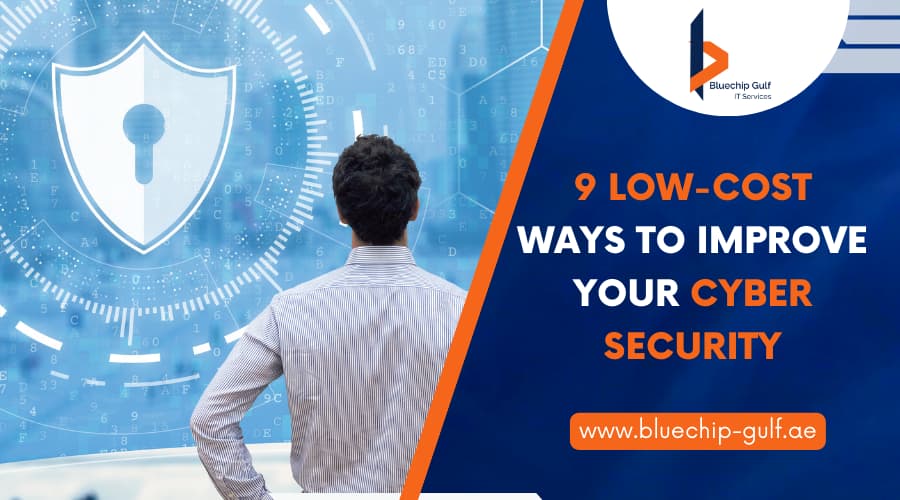
In Today’s cyber threats landscape, remote working boosted big data volumes, and growingly modern cyber criminals are all elements that have in addition. As cyber security becomes a growing precedent, several businesses are seeking new and original paths to decrease the risk of neglect. To gain global access, organizations should ensure that they settle inaugural, safeguarding, and flexible quantities.
- Prepare- Preparations or construction is the simple or fast step for companies to gain before the threat does something.
- Protect- Settled cyber security technique by exacting stabbing tests and other insight-gaining procedures.
- Respond- Proceed to cyber attacks farsighted to stop the violation in its earliest stages and stop more breakages.
In this blog, we deliver 9 cost-effective ways to improve cyber security.
9 Ways to Improve Your Cyber Security
Cyber threats or attacks endure predestined reactions to operating in Cyber security. It doesn’t matter if company defenses are good or bad, they can be the target of malware, ransomware attacks, or data disclosure caused by human error.
So how to improve your cyber security? Start with an easy process. Preparation is the first key that companies should take to ensure they can face and fight against cyber attacks. Along with this, it is also the most cost-effective security procedure, and it is capable of blocking a large part of cyber attacks before they are accomplished.
1. Password management
Weak passwords are a widely recognized vulnerability that significantly heightens the risk of security breaches. Mobile devices are increasingly susceptible to password spraying tactics due to their widespread usage, inherent susceptibility to compromise, and the potential for misconfigurations that can compromise their security.
Settling good password-clear policies with an organization is a simple procedure to improve cyber security measures. This could include:
Check employees from utilizing one password for a fixed time, boosting long-term shield.
It is simple to automate your system to neglect repeat passwords. If one account is broken, your system will be in a good zone to stop more breakage.
Added some extra numbers and symbols created for strong passwords that make sure password diffusion is unsuccessful.
2. Effective Training
Effective training is a simple form to carry out good security from the bottom up, similar to password management policies. Along with this, it is also cost-effective. 85% of breaking involves a human segment, employees are the first line of security in stopping a cyber attack.
Some key training procedures that can deliver a company’s cyber security are
Teaching good internet and social media practices- Starting from clearing your collection regularly to operating secure browsers, settled internet security from the beginning helps with creating a culture of security.
Recognizing Phishing Schemes- There are several free services open that help you train your workers how to neglect phishing frauds.
Securing personal devices- Safeguarding a personal device begins with establishing a strong, erratic password, and continues into day-to-day browsing practice.
3. Gaining Insight
By taking insight into your company’s networks, you know what elements are prime responsive to attack, where developments are required, and make sure that your employees are cyber aware. It is a vital way to prepare yourself for possible security threats.
4. Multi-Factor Authentication
In a big company, with several employees accessing and working in company networks increasing, the range for attacks is also boosted. MFA is an authentication procedure that needs user identity through multiple things like security questions, location, ID card, and biometric data and is vastly used as a simple procedure for stopping uncertified access. In 2023, growlingly harsh cyber security landscape, businesses will mostly use MFA as an additional coating of protection.
5. Regular Updates
In companies, continuous or regular updates are the prime element for keeping systems secure and working smoothly. To update your computer once a week is a good thing so that basic and mark updates can be installed. It is essential that as well as main network security updates, companies update their operating systems and web browsers. According to a report, cybercriminals will take cyber-attacks through the most basic susceptibility like poor access controls, outdated systems, and easy & simple passwords.
6. Install Antivirus Software
Antivirus software is also one of the most popular procedures for boosting cyber security, possibly because of its clarity. It is very simple to install and maintain and also stops ransomware attacks by quickly catching criminals. Antivirus software is software that works in the background and analyzes files before your computer opens them. Installing antivirus software is seen as an increase to other securities but not to solve all cyber threats.
7. Implementing a DMZ
A DMZ, or demilitarized zone, delivers a layer of security for companies for the collection or storage of high-value and personal data. It works as the subnetworks that stand between public and private networks, safeguarding the latter from insertion by the former. There are many other advantages of DMZ.
With the use of DMZ, cyberattackers can’t take access to any information about a system.
They are used for protecting high-value company data.
One of the giant tricky challenges to cloud security is to protect their data privacy and protection, which can be boosted through the use of non-traditional, cloud-compatible DMZ.
8. Develop a Disaster Recovery Plan
A disaster recovery plan (DRP) settled for suppleness against probable cyber attacks.
A pre-made recovery plan permits an enterprise to get back on its ground fast, relieving financial loss and other breakage to accommodation elements.
The key stages of a disaster plan are:
Data triage
Analysis
Containment
Recovery
Reviews
DRPs can help companies discover more information about their own interior data and data processes, and upgrade both long and short-term protection.
9. Managed IP Service Providers-
Companies that work within multiple security environments may have advantages from expert support. Managed IT service providers deliver clients security advice, performance support, and ongoing maintenance, according to their prime requirements and goals. A managed IT service provider can deliver help to businesses that continue working within tight security budgets, who require to make sure their security systems are as cost-effective as possible.


